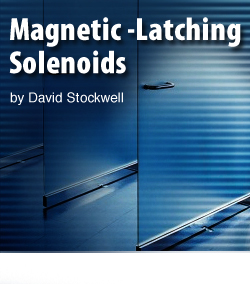When designing a mechanical assembly, which incorporates a solenoid, one can avoid mounting pitfalls by exploring the unique advantages and disadvantages of the various installation approaches.
1. Installations where mounting screws are the optimal mounting option:
Many C-Frame and D-Frame solenoids can utilize mounting screws that sink directly into the solenoid’s frame. Because the solenoid coil is typically less than 1/8” beyond the threaded holes of the metal frame, the length of the screw selected is key. The screw should be long enough to provide sufficient thread engagement to securely hold the solenoid in place, but it should not protrude into the solenoid to impinge on the coil.
2. Installations where mounting screws are not an option:
Threaded/Slotted Mounting: Tubular (cylindrical) solenoids typically mount by designing either the front end or the back end of the solenoid to include a thread (which would be used with a matching nut), or a slot (which would be used with a retaining e-ring, or similar device). In such mounting scenarios, tubular solenoids can be shimmed to ensure correct alignment/location in the assembly. A lock nut/washer can also be added to improve resistance to shock and vibration, and to further ensure that the solenoid will remain in the desired position.
Nest Style Mounting: Solenoids of all types can be placed into a “nest” in the customer’s product. This “snap-in” approach, which traps/envelops the solenoid body, can prove very effective for holding a solenoid in place.
Bracket Mounting: A separate mounting bracket can be attached to a solenoid with screws, a nut, and/or with permanent spot welds. The mounting bracket can then be affixed to the customer’s assembly in a variety of ways.
3. The degree of Flexure/Deflection the mounting approach adds to the system:
Applications that can provide tight tolerances and rigid mounting materials have a distinct advantage relative to gaining maximum performance from a solenoid.
Applications that involve multiple components to mount a solenoid should be prototyped and thoroughly tested in order to measure and to ensure that the degree of deflection that might result from mechanical stress does not impact either the solenoid’s or the system’s performance.
To protect fragile system components from the shock and vibration associated with the actuation of the solenoid and/or to reduce the sound created upon solenoid actuation, compliant mechanical isolators may be incorporated into the mounting design solution.
4. The proper alignment of a mounted solenoid:
Slotted mounting holes in the application mounting surface and/or in the solenoid’s mounting bracket, can help to accommodate system assembly tolerances, thereby ensuring that the solenoid is optimally located in the device.
5. Mounting style relative to product life and expectations for solenoid performance:
Certain attachment methods wear better than others relative to the mounting methods and materials that are used. Some mounting designs may mechanically “creep” or otherwise deteriorate over time. Such creep/movement or deterioration can negatively impact the force-stroke performance characteristics of the solenoid, thereby deriding the solenoid’s effectiveness.
For products intended for use in long-life, severe shock and vibration, and/or thermally deleterious applications, caution is advised when specifying the solenoid mounting style. Factors and conditions including the physical handling of the device, chemical exposure, thermal fatigue, and the material fatigue properties of both the solenoid mounting system and the surface to which the solenoid is mounted, must be taken into consideration.
6. Residual Magnetism:
An often asked question is, what consequences might the magnetic field that is created by repeatedly energizing and de-energizing the solenoid, have on the end product’s mounting surface, or on any electronic circuitry that is either connected or in close proximity to the solenoid?
If a solenoid is mounted directly onto a ferrous or other such magnetic material, a small residual magnetism may be imparted to the mounting surface.
Electronic components and the overall circuitry which either drive the solenoid or are located in the vicinity of the solenoid, may be affected by:
- The solenoid’s magnetic field,
- Electronic in-rush current: a pulse of energy generated when a solenoid is activated, or
- Electronic back-EMF current: a pulse of energy generated when a solenoid is de-energized.
The solenoid manufacturer can offer some initial direction and advice relative to how these three characteristics might impact system components. In the end, the only way to truly measure the effect of the solenoid on its surroundings is for the system designer to thoroughly test the solenoid in the application.
If/when specific problems are identified, the solenoid manufacturer can recommend potential remedies (i.e. the addition of in-rush limiting electronic components, such as diodes and MOV’s, to the solenoid drive circuitry).
Have you encountered issues installing or mounting solenoids? Please share your experiences below.
As a leading manufacturer of standard, specialty and custom Electromagnetic devices—Electromechanical and Electrohydraulic—MSA’s advanced engineering, innovative design and lean manufacturing capabilities enable our customer’s products to outperform their competition.
To explore how your system performance can be enhanced by MSA’s installation and mounting solutions, Contact MSA Today
By Paul Schmitt, Project Engineer at Magnet-Schultz of America, Inc.







Leave A Comment